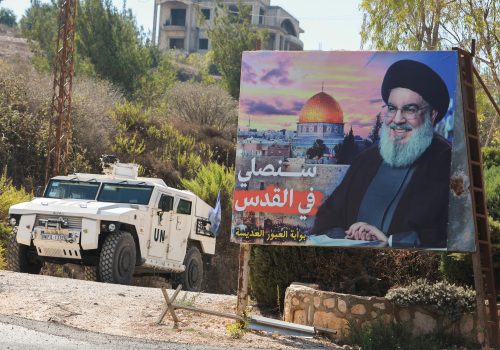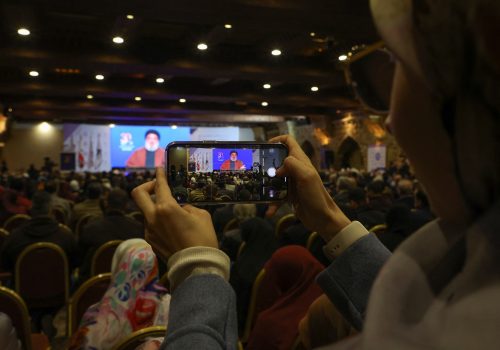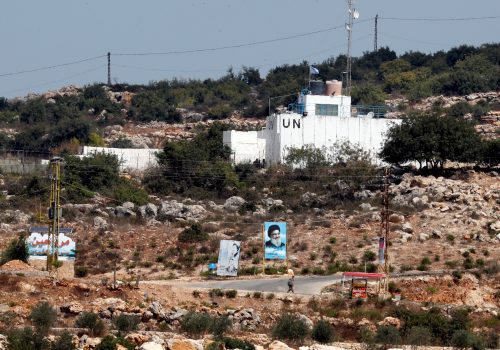April 13, 2023
Hezbollah and its allies are more emboldened than they’ve been in nearly two decades
A tense calm has returned to the Lebanon-Israel border days after an unknown group launched a barrage of rocket fire at Israel from inside Lebanon. This marked the most serious bout of violence in the area in more than sixteen years.
The attack on April 6—in which thirty-four 122mm Grad rockets were launched from a coastal strip south of Tyre in south Lebanon and struck areas of western Galilee—was seen as a response to Israeli security forces beating worshippers at the Aqsa Mosque in Jerusalem a day earlier (the video of which went viral and inflamed anger across the region). Of the thirty-four rockets, twenty-five were intercepted by the anti-missile Iron Dome system. At least one Israeli civilian was wounded, and vehicles and houses were damaged.
There was no claim of responsibility for the rocket barrage, which was followed on the evening of April 6 by a handful of suspected mortar rounds or short-range rockets fired from the Marjayoun area toward Metulla in northern Galilee. Palestinian Islamic Jihad hailed the rockets from Lebanon as “a heroic operation against the Israeli crimes in the Aqsa Mosque.” A source belonging to Hezbollah told the Al Arabiya network that the Iran-backed organization was not responsible, although there was no official comment from the party. After some deliberation, Israel publicly blamed Palestinian groups.
“It’s a Palestinian-oriented event,” said Lieutenant Colonel Richard Hecht, an Israeli military spokesman, adding that it could have been either Hamas or Palestinian Islamic Jihad.
In response, Israel struck targets in Gaza with fifty tons of bombs. Israel also staged air strikes against three targets south of Tyre—one close to the Rashidieh Palestinian Refugee Camp. There was no further rocket fire from Lebanon and the brief bout of violence appears to have ended for now.
There are a number of takeaways from this latest outburst along the Lebanon-Israel border.
First, the perpetrators of the rocket and mortar fire against western and northern Galilee were most likely Hezbollah personnel, not members of Hamas or any other Palestinian faction. In August 2021, I argued that Hezbollah was almost certainly the culprit behind the latest spate of rocket fire from Lebanon into Israel—despite Israel blaming a Palestinian faction—and probably almost all the others since the end of the 2006 war between Hezbollah and Israel. My analysis has only been reinforced by the April 6 rocket attacks along the Lebanon-Israel border.
There were six locations where rocket launchers were erected, according to UNIFIL sources, but only three of those locations were used. The Lebanese Armed Forces (LAF) discovered launchers fitted with unfired rockets at the other three locations. Four locations were in orange orchards just north of the village of Qlayle in the coastal strip south of Tyre. The other two locations were in open ground midway between the villages of Zibqine and Jbal Botm. Qlayle, Zibqine, and Jbal Botm are all bastions of strong Hezbollah support and were located on the frontline of Israel’s occupation zone in south Lebanon in the 1990s. Of the twenty-one successful or attempted rocket attacks against Israel from south Lebanon since the 2006 war, nine of them were launched from an eight-mile-long coastal strip running south of Tyre, according to my tally. Five of those nine attacks emanated from the immediate vicinity of Qlayle.
Even in the 1990s, during the Israeli occupation of south Lebanon, the orange orchards around Qlayle were known as a regular source of rocket fire into Israel. When a patrol from the United Nations peacekeeping force in south Lebanon, known as United Nations Interim Force in Lebanon (UNIFIL), went to investigate a rocket launch from the Qlayle area in May 2021, it encountered a pickup truck full of armed men who told the peacekeepers to leave immediately. In the opinion of the UNIFIL soldiers, they were not Palestinians but local Lebanese.
The periodic episodes of post-2006 rocket fire from south Lebanon into Israel are routinely blamed on Palestinian factions by Israeli and Lebanese security officials. The reasoning is that they usually coincide with Israeli military campaigns against Hamas in the Gaza Strip, thus, providing a motive. Additionally, the attacks are invariably amateurish, consisting of relatively obtainable 107mm or 122mm rockets fired from crude single launchers, rather than multiple-barrel systems for which they are designed, with the projectiles often falling short of the border or crashing into the sea. Yet, in the sixteen years of these sporadic rocket launches, not a single Palestinian has been apprehended by Hezbollah or the LAF.
Take the latest salvo on April 6. If the Israeli assumption that Hamas was responsible is correct, then the operation would have involved at least six teams carrying more than thirty-four rockets (some were found unfired of course) from some origin further north (a Palestinian refugee camp perhaps), erecting the launchers in broad daylight, firing the rockets, and somehow exfiltrating the area without anyone seeing, including Hezbollah, which watches movements in its areas like a hawk. Furthermore, another Hamas team would have had to sneak into the Marjayoun area later in the day to lob a few mortar shells or 107mm Katyusha rockets toward Metulla, again evading capture. The LAF subsequently discovered a Katyusha launcher fitted with rockets near Marjayoun.
The obvious conclusion, therefore, is that, if Hamas was responsible—or other Palestinian factions in previous attacks—they were all carried out in collusion with Hezbollah. Given the scale of the April 6 rocket attack, it is unthinkable that Hamas would have unilaterally conducted such a heavy barrage without coordinating with its Lebanese ally, especially as Hezbollah jealously guards its tactical control of the border with Israel.
Hecht, the Israeli military spokesman, while blaming Hamas, added that the military believed that Hezbollah and the Lebanese government was aware of what happened and held responsibility. In addition, Tamir Hayman, a former head of Israeli military intelligence, said on Twitter, “It’s not Hezbollah shooting, but it’s hard to believe that Hezbollah didn’t know about it.”
The comments of Israeli officials point to the rocket barrage being a jointly-coordinated operation between Hezbollah and Hamas, which it almost certainly was. Yet, if both Hezbollah and Hamas are responsible, then the identity of the perpetrators who fired the rockets becomes irrelevant. Indeed, logistically it would have been much simpler for local Hezbollah men to pop out of their villages, erect the launchers, fire the rockets, and return to their nearby homes, rather than having the burden of bussing multiple teams of Palestinians—who were probably unfamiliar with the local terrain—from further north, and then sending them back again afterward.
The second takeaway is the Israeli response to the rocket barrage. Blaming Hamas served as a significant de-escalatory signal. If Israel had directly accused Hezbollah of the rocket assault, the Israeli military would been compelled to retaliate against Hezbollah targets, risking an escalation that could have led to all-out war. Instead, blaming Hamas, while hinting at possible Hezbollah involvement, was the easier and safer option, especially given the minimal casualties and damage inside Israel from the rocket strike.
Gaza, 112 miles south of Lebanon, bore the brunt of the Israeli retaliation. Israel staged three air strikes south of Tyre on what the Israeli military described as Hamas “infrastructure targets.” However, the targets were three orange orchards, one 500 yards east of the Rashidieh Palestinian Refugee Camp. The air strikes left deep craters in the orchards, killing a handful of goats and damaging some agricultural sheds.
The bottom line of this latest flare-up of violence along the Lebanon-Israel border is that Hezbollah, in coordination with Hamas, launched the largest barrage of rockets into Israel in nearly seventeen years without facing any repercussions.
The third takeaway is the broader context in which the rocket attack occurred. Hamas officially restored relations with Syria in October 2022, a decade after severing ties and leaving their offices in Damascus in response to the regime’s crackdown against protestors. The move placed Hamas once more within the Iran-led Axis of Resistance, which includes Syria, Hezbollah, Palestinian Islamic Jihad, and other regional militias and factions opposed to Israel and Western ambitions in the Middle East. The rapprochement came during months of increased unrest in the Occupied Palestinian Territories, especially in the West Bank, amid speculation that a third intifada may soon be underway. Hezbollah also has been closely eyeing developments in the Occupied Territories as well as the recent turmoil in Israel over the judicial reforms.
Developments in Israel and the West Bank appear to have encouraged Hezbollah, Hamas, and Islamic Jihad to take advantage of the unrest and coordinate more closely. Ismael Haniyeh, the leader of Hamas, was in Beirut on April 6 and subsequently held talks with Hassan Nasrallah, Hezbollah’s secretary-general. In a statement, Nasrallah and Haniyeh discussed “the most important developments in occupied Palestine, the course of events at Aqsa Mosque, and the escalating resistance in the West Bank and Gaza, in addition to…the readiness of the Axis of Resistance and the cooperation of its parties.”
In March, Israel accused Hezbollah of an unusual roadside bomb attack in Megiddo in central Israel in which an Israeli Arab was wounded. The perpetrator is believed to have slipped across the border from Lebanon into Israel. The still unidentified bomber, carrying a suicide belt and rifle, was intercepted in north Israel—apparently while heading back to the border—and shot dead.
The rocket barrage into Israel, while catalyzed by the violence a day earlier in Aqsa, suggests that a lowkey, deniable uptick of anti-Israel operations may be underway along Israel’s northern front. On April 1, a drone flew from Syria into Israeli territory before being shot down. On April 8, three rockets were fired from Syria toward Israel. The Megiddo bombing and the April 6 rocket barrage are indications that Hezbollah has grown emboldened by the unrest in Israel and is adopting a more confrontational stance against Israel compared to the party’s previously cautious attitude since 2006.
That more assertive posture mirrors Hezbollah’s increasingly brazen behavior in the UNIFIL Area of Operations where it has established publicly visible military positions, several firing ranges (two of them are located one mile and two miles respectively from one of the April 6 rocket launch sites), and observation towers some sixty feet tall along the border (technically manned by a Hezbollah-affiliated environmental NGO called Green Without Borders).
Given the recent uptick in activity along Israel’s northern border, the enhanced coordination between Hezbollah, Hamas, and Palestinian Islamic Jihad, the turmoil in Israel and the West Bank, and the relatively reserved reaction to the largest rocket attack from Lebanon since 2006, Hezbollah and its allies have likely been encouraged to further test Israel in the weeks ahead, accepting all the inherent risks this entails.
Nicholas Blanford is a nonresident senior fellow with the Atlantic Council’s Middle East Programs.
Further reading
Wed, Apr 5, 2023
A series of unrelated events happened in Israel. Fingers are pointing at Hezbollah.
IranSource By David Daoud
Tensions have been unusually high along the Lebanese-Israeli border. But war, or a large-scale conflagration, is not imminent.
Wed, Apr 12, 2023
The attacks on Israel should be a wake up call for the Lebanese people
IranSource By Nour Dabboussi
The rocket fire from Lebanon on April 6 highlights how Hezbollah continues to act as a separate military and political entity in the country, with external militia groups holding goals and ideologies that further Iran’s regional endeavors.
Fri, Mar 12, 2021
Hezbollah is using propaganda to cover its deterrence deficit with Israel
MENASource By David Daoud
Hezbollah won’t necessarily suspend all operations against its archenemy, but it will have to deftly navigate both Lebanon’s predicaments and its support base’s expectations.
Image: An Israeli military tank is pictured at the Israeli-Lebanese borders, after an intercepted rocket fired from Lebanon hit northern Israel.


